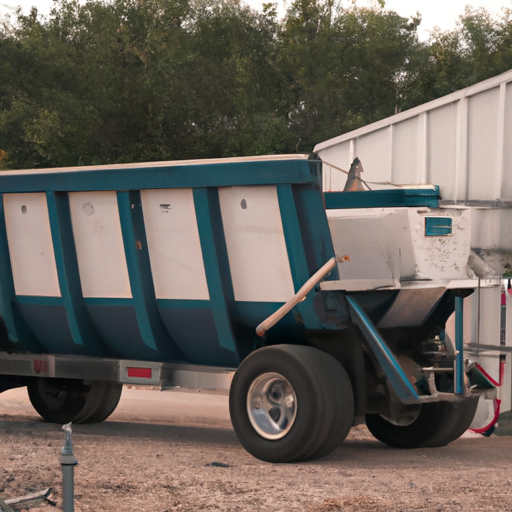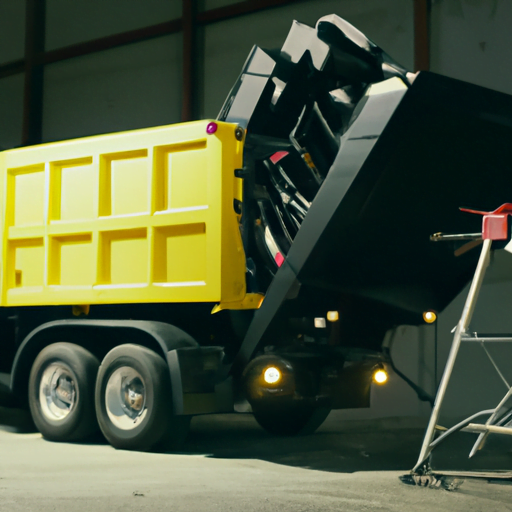-
Table of Contents
Introduction
Heavy Duty Dump Trailers are an integral part of many construction, farming, and waste management operations. These powerful pieces of equipment can carry hefty loads ranging from debris to large materials. However, improper loading could pose risks not only to the trailer but also to people around it. This guide will introduce how to properly load your heavy-duty dump trailer, discussing vital steps such as weight distribution, safety measures during the loading process and precautions that need to be adhered for efficient operation. The aim is to ensure maximum utilization of the dump trailer while reducing potential accidents or damages associated with improper use.
Key Steps to Correctly Load Your Heavy Duty Dump Trailer
Heavy duty dump trailers are an invaluable tool for transporting large quantities of materials, from construction debris to landscaping supplies. However, loading these giant haulers comes with its own set of challenges that require a specific knowledge base and expertise. Without the right approach to loading your trailer, you may risk damaging equipment or endangering safety.
Before attempting to load your heavy-duty dump trailer, it’s essential to understand its payload capacity first. This is typically indicated in the owner’s manual or on a sticker placed somewhere on the trailer itself. Every dump trailer has a weight limit which should never be exceeded since this could lead to dangerous conditions due to overloading.
Now let’s move onto actually loading your dump trailer correctly – much hinges upon distributing weight evenly across the bed of the vehicle. A lot depends on what type of material you’re hauling too – lighter materials such as mulch can be loaded more haphazardly than heavier items like concrete blocks, which need careful placement for stability during transit. As you load up each item into your trailer, aim towards maintaining balance; if possible, keep most of the load centered between its wheels instead all at one end or spread unevenly across it.
It’s also worth noting when handling denser loads; they should always go at the bottom with lighter ones stacked carefully atop them- much akin how we pack our suitcase while travelling! Heavier items provide a firm base that will prevent toppling while light goods can easily fit into spots around their bulkier counterparts reducing chances of movement during travel.
While there’s no hard-and-fast rule about whether front-loading or back-loading works best (again because different materials have different needs), generally speaking though, placing heavier items toward front part helps maintain inertia better when hill climbing whilst aiding brake performance on downhill descents- enhancing overall driving control.
Your caution flags shouldn’t just fly off after ensuring balanced and safe stacking only—the binding comes next! Always secure loose ends, prevent material movement and eliminate any possibility of your cargo flying out as you drive down the road. You can use strong straps or netting to secure the items within the trailer to ensure maximum stability during transit.
Lastly, but equally important is conducting a final walk-through inspection before kicking off your journey. This includes verifying whether all lights are functional (turn signals, brake lights), checking tire pressure for optimal performance and confirming coupling devices have been properly secured. Also check if all safety chains are connected and cross them under your hitch to provide additional support in case of accidental uncoupling – better safe than sorry!
To sum up everything- loading a heavy-duty dump trailer correctly isn’t rocket science but does require diligent attention towards details like knowing vehicle’s payload capacity, understanding how different materials affect weight distribution within it, managing load balance effectively so that no side gets unfairly stressed-out plus securing every damn thing tightly enough so they don’t get chance even contemplate escape while en-route! And made sure each light’s glowing like goodnight star before stepping on accelerator!
Remember: When loaded correctly, not only will your heavy duty dump trailer perform optimally during transit by minimizing risks associated with instability or losing some of its precious cargo along way; you’ll also prolong its service life time since stress evenly distributed across body doesn’t hasten wear tear unnecessarily—Now let’s load that sucker up right first time around shall we?
The Ultimate Guide to Safely Loading a Heavy Duty Dump Trailer
Loading a heavy-duty dump trailer safely and effectively may seem like an intimidating prospect, but with the right knowledge under your belt and consistent practice, it can quickly become second nature. Precise loading is essential when you want to prevent damage to your trailer or goods or minimize the risk of accidents during transit.
Your primary concern should be weight distribution. Properly balancing the load across the whole body of your dump trailer will enhance stability during transportation, reduce strain on one side, and increase safety. The best way to achieve this is by systematically placing heavier items at the center as much as possible while evenly distributing lighter elements around them. You’ll also want to avoid overloading in general; every trailer has a specific maximum capacity that shouldn’t be overlooked.
Secondly, being mindful about how you stack items in your dump trailers could significantly influence stability. Ideally, aim for a low center of gravity by placing heftier items at the bottom and stacking up from there with progressively lighter commodities. Doing so ensures that even if there’s sudden braking or swerving while in transit, these forces won’t easily topple the stacked goods leading to imbalance.
Moving onto tie-downs – they are paramount! To secure loads firmly into place within heavy-duty dump trailers without squishing delicate stuff below, use sturdy straps or chains rated appropriately for the weight of what they’re tying down. These ties should form an ‘x’ pattern over top-heavy objects since this provides additional security against any lateral (sideways) movements aside from vertical motion control provided by just going straight across.
Another crucial aspect not often given attention while loading heavy-duty dump trucks is considering shapes and sizes accordingly when arranging items inside it; irregularities present challenges as they result in gaps which affect balance negatively especially during motions on uneven terrains like off-road situations etc; smart solution here would involve filling such spaces using smaller stable pieces thereby increasing overall compactness thus reducing chances destabilization later due towing.
Lastly, as part of your loading process, it’s essential to inspect and test your load before heading out. Check whether items are indeed secure within the trailer by simulating some sort of movement (like a rough ride) – if anything shifts or falls off, that’s an early warning sign demanding immediate remediation; better now than having road mishaps later!
It may seem like there’s a lot going on when we talk about properly loading a heavy-duty dump trailer but in reality it all boils down to being mindful of weight distribution, securing loads well with tie-downs after careful stacking considering item attributes & filling gaps wisely then finally confirming firmness via inspection cum testing beforehand. Be patient while learning this skill because safety isn’t something you can compromise upon especially dealing such massive pieces machinery regularly.
Remember: Safe practices not only help to avoid potential accidents but also prolong the life and functionality of your equipment. As they say – “Slow is smooth, and smooth is fast”. So take your time initially while working for these nuances in loading procedures until gradually becoming proficient at them eventually turning into habits consequently resulting smoother duties taking lesser time overall!
Essential Tips and Techniques for Loading Your Heavy-Duty Dump Trailer
When it comes to loading your heavy-duty dump trailer, doing it properly is more than just a suggestion. It’s essential for safety and efficiency, not to mention the lifespan of your equipment. After all, these aren’t toys we’re dealing with – they’re serious pieces of machinery that can do a lot of damage if not handled correctly.
Let’s begin with preparing the dump trailer itself. First and foremost, inspect your dump trailer thoroughly before each use. Check for any potential mechanical or structural issues that could result in an accident during operation. You should look for signs like cracks in the bodywork or frame, as well as worn-out hydraulics and electrical systems.
Now onto load distribution – one little secret shared by veteran operators is their special attention to how weight is distributed on their trailers when loading them up. The ideal way to distribute load weight is evenly across the bed of the dump trailer; this prevents tipping and helps ensure better control when you’re driving around or unloading later on.
Plus, there’s always some space management involved in proper loading techniques too – fitting items together efficiently helps make sure you are utilizing every inch available without compromising stability or overburdening certain sections.
Moving on from there but still staying within parameters of crucial considerations: what type (size) and amount? Too often people overload their trailers thinking they’re saving time only to realize that an overloaded trailer isn’t just hard-to-control but also unsafe both for operator, road users and equipment alike! A general rule thumb here would be never exceeding manufacturer’s suggested weight limit—counterproductive efforts don’t end well usually!
As part of good practice when packing up things into your heavy-duty babies; larger items should go at bottom while smaller ones need find room higher up. This maintains stability during transport significantly reducing chances accidents occurring due falling debris unexpected shift inside cargo bay area along journey
But remember! Before engaging motion check put place firmly secured tie-down points provided majority newer models today. Whether ratchet straps, chains or any other form restraint it’s crucial ensure load firmly secured avoid unnecessary movement which could destabilize dump trailer result in potential accident.
In terms of loading order – consider the items and their place when unloading. You’d want to offload your lighter waste materials first before dealing with those heavy debris. This way you can eliminate back strain and risk of injury when emptying out your trailer.
Unloading too is an art unto itself – balancing between forceful ejection through hydraulics and manual removal of cargo determines how clean a job you’ll do while also sparingly using machine’s energy reserves for peak performance throughout work cycle.
Lastly, never forget your personal safety! Work gloves, steel-toed boots, hard hats – they aren’t fashion statements but critical components protecting you from possible harm while around such heavy duty machinery.
In conclusion, mastering the art of properly loading your heavy-duty dump trailers takes time and practice but attention to these core aspects goes a long way in ensuring safe routine operations; prolonging equipment service life not forgetting boosting overall productivity. Loading right isn’t just about doing things efficiently—it’s about doing them well!
Q&A
Question 1: What are the basic steps to properly load a heavy duty dump trailer?
Answer: The basic steps include carrying out a thorough inspection of the trailer before loading, distributing weight evenly across the axle for balance, avoiding overloading as it might cause damage and ensuring that all materials are securely fastened.
Question 2: How should I distribute the weight on my dump trailer?
Answer: The weight should be distributed evenly throughout your dump trailer. Load heavier items at bottom and in center of your trailer, between its wheels. This central placement helps improve control while driving and prevents tipping or swaying.
Question 3: Why is it important to secure loads in a heavy-duty dump trailer?
Answer: It’s crucial to secure loads because any movement during transit can result in material shifting which can affect steering or braking. Unsecured cargo may also pose risks such as spillage or debris flying out causing hazards on roads.
Conclusion
In conclusion, to properly load a heavy duty dump trailer, ensure your load is evenly distributed to maintain stability and prevent tipping. Always adhere to the maximum weight capacity of the trailer. Use suitable loading equipment for safety purposes and remember to secure your load properly before transit, preventing movement that could cause damage or accidents. Regular maintenance of your dump trailer is also essential in ensuring durability and optimal performance.


